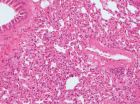(Press-News.org) This news release is available in German.
Apoptosis is used by cells that are changed by disease or are simply not needed any longer to eliminate themselves before they become a hazard to the body—on a cellular level, death is part of life. Disruption of this process can lead to cancer or immunodeficiencies, but also to autoimmune diseases, in which cells attack their own body.
HZI scientist Prof Ingo Schmitz and his team investigate the regulation of apoptosis in the immune system. In collaboration with researchers of the Otto von Guericke University Magdeburg and the Helmholtz Zentrum München, they elucidated the role of a central protein in this process. The researchers published their results in "Cell Death & Disease". So-called c-FLIP proteins inhibit signaling cascades that can lead to apoptosis. This is important temporarily in the response to pathogens to ensure that lymphocytes, a type of immune cells, can proliferate sufficiently. Towards the end of the immune response, once the lymphocytes completed their tasks and successfully eliminated the pathogen, c-FLIP is usually degraded. As a result, apoptosis is enabled again, the lymphocytes die and the equilibrium in the immune system is restored.
The HZI researchers then took a closer look at the exact function of a certain variant of the protein, called c-FLIPR. They used mice to investigate what happens if this protein is always present in lymphocytes and other blood cells. Whereas the apoptosis inhibitor caused no anomalies in young mice, the scenario in older mice was quite different: "The composition of the lymphocytes was changed significantly," says Schmitz. "Furthermore the immune cells were strongly activated."
The overactivation is easily apparent in the body. The researchers found immune molecules, called autoantibodies, which attack the body's own tissue in the kidneys and lung. In addition, they detected harmful protein deposits in the kidneys. The changes in the lung tissue are also indicative of the immune system attacking its own body in the presence of too much c-FLIPR. "Immune cells migrate into the lung and attack the lung tissue," says Schmitz. Physicians usually see these symptoms in a human autoimmune disease called systemic lupus erythematosus
The HZI scientists discovered already last year that cells can fight bacterial infections better if c-FLIPR is turned on permanently. This means that inhibiting the suicide of cells has beneficial effects in acute infections, but leads to autoimmune reactions in the long run. "c-FLIPR is important for the balance of the immune system. It might be possible to intervene with suitable therapeutic agents if the equilibrium of the immune system is disrupted," says Schmitz.
INFORMATION:
Original publication
Frida Ewald, Michaela Annemann, Marina C. Pils, Carlos Plaza-Sirvent, Frauke Neff, Christian Erck, Dirk Reinhold, Ingo Schmitz
Constitutive expression of murine c-FLIPR causes autoimmunity in aged mice
Cell Death & Disease, 2014
The research group "Systems-oriented Immunology and Inflammation Research" studies the molecular processes that sensitize immune cells to the body's own tissues. A main focus is on the cellular suicide programme apoptosis.
The Helmholtz Centre for Infection Research (HZI)
Scientists at the Helmholtz Centre for Infection Research in Braunschweig, Germany, are engaged in the study of different mechanisms of infection and of the body's response to infection. Helping to improve the scientific community's understanding of a given bacterium's or virus' pathogenicity is key to developing effective new treatments and vaccines.
http://www.helmholtz-hzi.de
Sensitive balance in the immune system
Too much of a protein called c-FLIPR can trigger autoimmune diseases
2014-04-11
ELSE PRESS RELEASES FROM THIS DATE:
New data reveals positive outcomes for hepatitis C transplant patients
2014-04-11
London, United Kingdom, Friday 11 April 2014: New research announced at the International Liver CongressTM 2014 today provides new hope for the notoriously difficult-to-treat population of liver transplant patients with recurring hepatitis C (HCV).
As part of a compassionate use program, 104 post-liver transplant patients with recurring HCV who had exhausted all treatment options and had poor clinical prognoses, received sofosbuvir (SOF) and ribavirin (RBV) with pegylated interferon (PEG) included at the physicians’ discretion for up to 48 weeks. Among patients whose ...
Viral hepatitis more deadly than HIV in Europe
2014-04-11
London, UK, Friday 11 April 2014: Mortality from viral hepatitis is significantly higher than from HIV/AIDS across EU countries, according to results from The Global Burden of Disease Study 2010 (GBD 2010) which was announced for the first time today at the International Liver CongressTM 2014(1).
GBD 2010 is the most recent version of a large epidemiological study funded by the Bill and Melinda Gates Foundation and coordinated by the Institute for Health Metrics and Evaluation (IHME) at the University of Washington.
In the EU, in 2010, there were more than 10 times ...
Immunotherapy could help tackle tough liver cancer
2014-04-11
London, England, Friday 11 April 2014 Significant new data presented today at the International Liver Congress™ 2014 indicate that liver cancer (Hepatocellular Carcinoma (HCC)) may be treated by adoptive T-cell therapy.
This new therapeutic approach in the treatment of HCC could be very important as without treatment the 5 year survival rate is just 5%. Globally, HCC accounts for 746,000 deaths, and in the UK alone is responsible for over 4,000 deaths per year.
Glypican-3 (GPC3) is a tumour associated antigen expressed in up to 70% of HCC but not in healthy human tissue. ...
Tamiflu & Relenza: How effective are they?
2014-04-11
Tamiflu (the antiviral drug oseltamivir) shortens symptoms of influenza by half a day, but there is no good evidence to support claims that it reduces admissions to hospital or complications of influenza. This is according to the updated Cochrane evidence review, published today by The Cochrane Collaboration, the independent, global healthcare research network and The BMJ. Evidence from treatment trials confirms increased risk of suffering from nausea and vomiting. And when Tamiflu was used in prevention trials there was an increased risk of headaches, psychiatric disturbances, ...
NASA sees hurricane-strength Tropical Cyclone Ita heading toward Queensland
2014-04-10
VIDEO:
On April 9, NASA's TRMM saw powerful storms in Ita's eye wall reached heights of over 14 km/8.7 miles. The tallest thunderstorm towers reached heights of over 16 km/9.9 miles...
Click here for more information.
Tropical Cyclone Ita has been strengthening over the last two days and by April 10, Ita had become a major hurricane in the Coral Sea when NASA's Terra satellite passed overhead.
Ita's maximum sustained winds were near 115 knots/132 mph/213 kph on April 10 at 0900 ...
Appearance of night-shining clouds has increased
2014-04-10
First spotted in 1885, silvery blue clouds sometimes hover in the night sky near the poles, appearing to give off their own glowing light. Known as noctilucent clouds, this phenomenon began to be sighted at lower and lower latitudes -- between the 40th and 50th parallel -- during the 20th century, causing scientists to wonder if the region these clouds inhabit had indeed changed -- information that would tie in with understanding the weather and climate of all Earth.
A NASA mission called Aeronomy of Ice in the Mesosphere, or AIM, was launched in 2007 to observe noctilucent ...
NASA simulation portrays ozone intrusions from aloft
2014-04-10
Outdoor enthusiasts in Colorado's Front Range are occasionally rewarded with remarkable visibility brought about by dry, clear air and wind. But it's what people in the mountainous U.S. West can't see in conditions like this – ozone plunging down to the ground from high in the stratosphere, the second layer of the atmosphere – that has attracted the interest of NASA scientists, university scientists and air quality managers.
Ozone in the stratosphere, located on average 10 to 48 kilometers (6 to 30 miles) above the ground, typically stays in the stratosphere. Not on days ...
NASA's Hubble extends stellar tape measure 10 times farther into space
2014-04-10
Using NASA's Hubble Space Telescope, astronomers now can precisely measure the distance of stars up to 10,000 light-years away -- 10 times farther than previously possible.
Astronomers have developed yet another novel way to use the 24-year-old space telescope by employing a technique called spatial scanning, which dramatically improves Hubble's accuracy for making angular measurements. The technique, when applied to the age-old method for gauging distances called astronomical parallax, extends Hubble's tape measure 10 times farther into space.
"This new capability ...
SU plays key role in search for elusive dark matter
2014-04-10
Physicist Richard Schnee hopes to find traces of dark matter by studying particles with low masses and interaction rates, some of which have never been probed before.
The ongoing search for invisible dark matter is the subject of a recent article involving physicists from Syracuse University's College of Arts and Sciences.
Research by Richard Schnee, assistant professor of physics, is referenced in Symmetry magazine, a joint publication of the Stanford Linear Accelerator Center in Palo Alto, Calif., and Fermilab in Batavia, Ill.
"Scientists looking for dark matter ...
SU geologists prove early Tibetan Plateau was larger than previously thought
2014-04-10
Earth scientists in Syracuse University's College of Arts and Sciences have determined that the Tibetan Plateau—the world's largest, highest, and flattest plateau—had a larger initial extent than previously documented.
Their discovery is the subject of an article in the journal Earth and Planetary Science Letters (Elsevier, 2014).
Gregory Hoke, assistant professor of Earth sciences, and Gregory Wissink, a Ph.D. student in his lab, have co-authored the article with Jing Liu-Zeng, director of the Division of Neotectonics and Geomorphology at the Institute for Geology, ...
LAST 30 PRESS RELEASES:
Interaction of climate change and human activity and its impact on plant diversity in Qinghai-Tibet plateau
From addressing uncertainty to national strategy: an interpretation of Professor Lim Siong Guan’s views
Clinical trials on AI language model use in digestive healthcare
Scientists improve robotic visual–inertial trajectory localization accuracy using cross-modal interaction and selection techniques
Correlation between cancer cachexia and immune-related adverse events in HCC
Human adipose tissue: a new source for functional organoids
Metro lines double as freight highways during off-peak hours, Beijing study shows
Biomedical functions and applications of nanomaterials in tumor diagnosis and treatment: perspectives from ophthalmic oncology
3D imaging unveils how passivation improves perovskite solar cell performance
Enriching framework Al sites in 8-membered rings of Cu-SSZ-39 zeolite to enhance low-temperature ammonia selective catalytic reduction performance
AI-powered RNA drug development: a new frontier in therapeutics
Decoupling the HOR enhancement on PtRu: Dynamically matching interfacial water to reaction coordinates
Sulfur isn’t poisonous when it synergistically acts with phosphine in olefins hydroformylation
URI researchers uncover molecular mechanisms behind speciation in corals
Chitin based carbon aerogel offers a cleaner way to store thermal energy
Tracing hidden sources of nitrate pollution in rapidly changing rural urban landscapes
Viruses on plastic pollution may quietly accelerate the spread of antibiotic resistance
Three UH Rainbow Babies & Children’s faculty elected to prestigious American Pediatric Society
Tunnel resilience models unveiled to aid post-earthquake recovery
Satellite communication systems: the future of 5G/6G connectivity
Space computing power networks: a new frontier for satellite technologies
Experiments advance potential of protein that makes hydrogen sulfide as a therapeutic target for Alzheimer’s disease
Examining private equity’s role in fertility care
Current Molecular Pharmacology achieves a landmark: real-time CiteScore advances to 7.2
Skeletal muscle epigenetic clocks developed using postmortem tissue from an Asian population
Estimating unemployment rates with social media data
Climate policies can backfire by eroding “green” values, study finds
Too much screen time too soon? A*STAR study links infant screen exposure to brain changes and teen anxiety
Global psychiatry mourns Professor Dan Stein, visionary who transformed mental health science across Africa and beyond
KIST develops eco-friendly palladium recovery technology to safeguard resource security
[Press-News.org] Sensitive balance in the immune systemToo much of a protein called c-FLIPR can trigger autoimmune diseases





